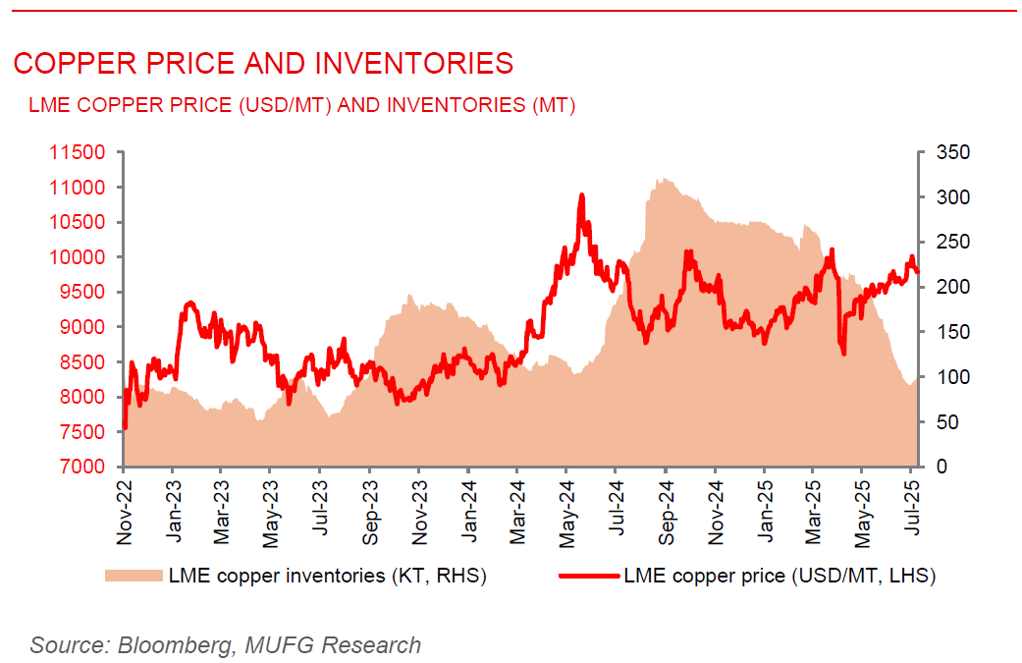To read the full report, please download the PDF above.
Middle East Daily
SOOJIN KIM
Research Analyst
DIFC Branch – Dubai
T: +44(4)387 5031
E: soojin.kim@ae.mufg.jp
MUFG Bank, Ltd. and MUFG Securities plc
A member of MUFG, a global financial group
Middle East Daily
COMMODITIES / ENERGY
Oil holds steady as inventory surge and tariff risks cloud outlook. Oil prices stabilised near USD70 for Brent and USD68 for WTI as traders weighed a sharp 7.1 million barrel increase in US crude inventories, the biggest since January if confirmed, and the potential demand impact of President Trump’s escalating tariff agenda, including new copper duties. While a fragile Middle East truce has eased geopolitical tensions, attention has returned to US trade policy and OPEC+ supply increases. Weak drilling activity and falling rig counts in the US have led to a cut in production growth forecasts, but the oil market still faces the risk of shifting into surplus after summer demand peaks.
Trump’s surprise copper tariff sparks record US price surge. Copper markets were rocked after President Trump announced a surprise 50% tariff on copper imports, triggering a record spike in US futures and a decline in global prices. Since February, when the potential tariffs were first flagged, traders rushed to ship record volumes of copper into the US ahead of implementation. The sudden policy shift pushed global benchmark on the London Metal Exchange (LME) slipped as much as 2.4%. The price gap between US and global copper soared to a 25% premium, an unprecedented divergence, reflecting expectations of a tighter US supply while overseas markets remain well stocked. The announcement comes as global copper demand is set to surge over the coming decade due to the energy transition, placing pressure on already constrained supply chains. Trump’s directive, issued under national security provisions, is expected to be enforced within weeks, raising concerns about import access for manufacturers and setting the stage for continued market volatility.
MIDDLE EAST - CREDIT TRADING
End of day comment – 08 July 2025. The market felt weaker yesterday afternoon and today we saw a continuation of it. ETF selling mainly in the afternoon shifted the balance to sellers from account side. In the morning there were some spread sellers on the back of UST weakness but equally started to see some yield buyers in the afternoon, especially in the long end. IG curves closed anywhere from unch to +2bp with a small steepening bias though. ADGB 54 were active closing -0.5pt/+2bp as did Qatar 49s closing -0.5pt/+2bp. With the still positive macro backdrop higher beta sovereign outperformed. Still not seeing sellers in OMAN and with every little inflow the bid seems to creep up. OMAN 51s closing +0.25pt/-5bp. MOROC remained quiet closing broadly -0.125pt/-0.25pt and unch in spread terms. Fins and corps had a quiet day overall, it feels like fins have sellers on the back of the Saudi fins issuance but the offers are not forcing a trade and most names closed broadly unchanged.
MIDDLE EAST - MACRO / MARKETS
Egypt’s FX reserves hit record high on gold surge and inflows. Egypt’s gross official reserves reached an all-time high of USD48.7bn in June, up 5% y/y, primarily driven by a 43% annual rise in gold reserves due to higher global gold prices. While foreign currency reserves saw a modest monthly increase of 0.8%, they declined 4.9% y/y as the effect of past large inflows, such as the May 2024 Ras El-Hekma investment, faded from the base. Net foreign assets in the banking system also improved significantly, rising to USD14.7bn in May, with commercial banks’ NFAs hitting USD4.8bn, the highest since February 2021. The reserve build-up supports Egypt’s debt reduction goals and helps maintain currency stability as the country recovers from high inflation and currency pressures in 2024. Recent reforms, exchange rate liberalisation, and inflows from multilateral deals, including over USD58bn in pledges since the IMF’s USD8bn program approval in March, have further strengthened Egypt’s external position.
BP and Shell re-engage in Libya’s oil sector with new agreements. BP and Shell have signed memorandums of understanding with Libya’s National Oil Corporation (NOC) to explore new opportunities in the country’s oil and gas sector, signalling a deeper return of international majors to the energy-rich North African nation. BP’s agreement includes a study to potentially revive the giant Sarir and Messla oil fields, discovered in the 1960s and 1970s. Shell confirmed it is also evaluating potential projects. These moves come as Libya, which holds around 48bn barrels of proven crude reserves, the largest in Africa, seek to ramp up production to 2mb/d in the coming years, despite a history of volatility due to political divisions and underinvestment since the 2011 civil war. Several international firms have resumed operations in Libya since last year, and the country is currently holding its first energy exploration tender in over a decade, aiming to boost output and stabilise long-term supply.

